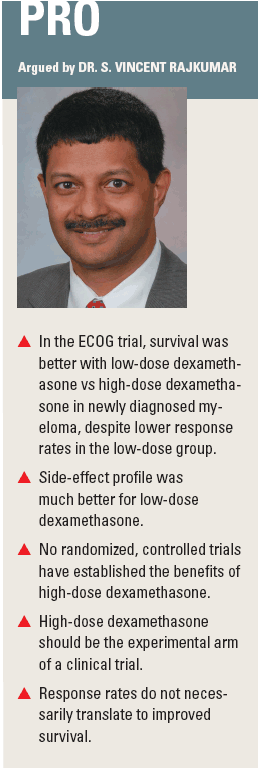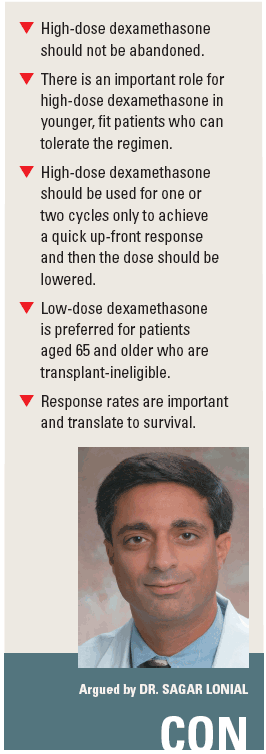From the ONI archives: Should low-dose induction dexamethasone be standard of care in multiple myeloma?
A phase III study by the Eastern Cooperative Oncology Group in patients with newly diagnosed multiple myeloma showed that induction therapy with low-dose dexamethasone plus lenalidomide (Revlimid) improved survival, compared with high-dose dexamethasone plus lenalidomide. Look for updates on treatment regimens that include dexamethasone in multiple myeloma at ASH 2010 from Sagar Lonial, MD, and S. Vincent Rajkumar, MD.
Despite evidence from a large, randomized trial in favor of a low-dose regimen, some experts are reluctant to abandon high-dose therapy in newly diagnosed multiple myeloma patients.
A phase III study by the Eastern Cooperative Oncology Group in patients with newly diagnosed multiple myeloma showed that induction therapy with low-dose dexamethasone plus lenalidomide (Revlimid) improved survival, compared with high-dose dexamethasone plus lenalidomide. Moreover, the low-dose regimen incurred fewer side effects and was easier for patients to tolerate.

Grade 3 or higher toxicity was 50% in the high-dose dexamethasone arm vs 30% in the low-dose arm. Deep vein thrombosis occurred in 25% vs 9%, respectively. Neutropenia was slightly higher in the low-dose arm (8% vs 19%, respectively), but more serious infections were seen in the high-dose arm: 19% vs 8%, respectively. There were more deaths within the first four months of the trial in the high-dose group: 5% vs 0.5%.
Despite this evidence from a large, randomized, controlled trial with 445 treatment-nave patients, some experts are reluctant to abandon high-dose dexamethasone in newly diagnosed multiple myeloma.
Lead author of the ECOG trial, S. Vincent Rajkumar, MD, professor of medicine at the Mayo Clinic in Rochester, Minn., espouses the benefits of low-dose dexamethasone. Sagar Lonial, MD, associate professor of hematology and medical oncology at Emory University in Atlanta, argues that high-dose dexamethasone should not be abandoned, especially in selected patients.
Rationale for low-dose dexamethasone
In an interview with Oncology News International, Dr. Rajkumar described the three principles that convince him that the low-dose option is preferable for newly diagnosed myeloma patients.
• The high-dose regimen is empiric. “Prior to the study I presented at ASH 2007, there were no studies comparing low- vs high-dose dexamethasone,” he said. “In fact, the ‘standard’ high-dose dexamethasone regimen is empiric, with no studies to support the specific need for high-dose dexamethasone or to show that it improves survival, compared with lower doses. We need to know the safe and effective dose of dexamethasone, as determined by a well-designed, randomized study.”
• The low-dose regimen has superior survival. The ECOG study is the only randomized trial designed to look at dexamethasone dosing as the variable, with other drugs in the regimen being the same, he said. The study showed that low-dose dexamethasone achieved superior short-term survival with much lower toxicity, Dr. Rajkumar noted. In addition, he said, endpoints like time to progression, progression-free survival, and response duration were similar, with a trend in favor of low-dose dexamethasone.
• The high-dose regimen is more toxic. If a more toxic treatment is used, it should be significantly better than a less toxic treatment, not just as effective, he said. “In the case of high-dose dexamethasone, it is not much better than low-dose dexamethasone, even in patients under age 65. In fact, it is the same or probably worse in terms of the endpoint that matters most-overall survival. No data show improved survival with high-dose dexamethasone,” Dr. Rajkumar stated.
In the ECOG trial, high-dose dexamethasone achieved higher response rates than low-dose dexamethasone, but this advantage failed to translate to better survival. Dr. Rajkumar said that response rates have often been unreliable in identifying regimens with the best overall survival. In fact, even complete response (CR) rates are sometimes unreliable.

During the first four cycles, response rates-CR and partial response (PR)-were 82% in the high-dose arm vs 79% in the low-dose arm. CR/very good PR rates were 52% vs 42%, respectively.
“The interactions between complete response and overall survival are similar to opinion polls done months before an election. They often predict the winner, but are not consistent,” he said. In his opinion, high-dose dexamethasone, which is more toxic than low-dose dexamethasone, should be the experimental arm of a clinical trial, not the standard arm. “I am more conservative. I want proof that high-dose dexamethasone leads to a better outcome in terms of survival,” Dr. Rajkumar said. He added that he believes all ongoing phase III studies in newly diagnosed patients have incorporated low-dose dexamethasone.
“Most community oncologists have also adopted the low-dose approach,” he said. “Given high toxicity rates of deep vein thrombosis and infections, the use of high-dose dexamethasone in myeloma should be done only in restricted situations, such as patients with aggressive relapsed myeloma, patients with renal failure for whom a rapid response is needed, and patients with limited therapeutic options.”
The high-dose road
Dr. Lonial took a different message from the ECOG trial. He told Oncology News International that when results were analyzed according to two different subgroups-transplant-ineligible patients age 65 and older vs younger patients-a survival difference favoring low-dose dexamethasone was seen only in the older patients.
The 12-month probability of survival was significantly greater for patients over age 65: 95% for low-dose dexamethasone vs 84% for high-dose dexamethasone (P = .01). However, survival in the younger patients was 97% for low-dose dexamethasone vs 92% for high-dose dexamethasone, a difference that was not statistically significant.
“For older patients, there was a big survival difference, and this group of patients should not get high-dose dexamethasone,” Dr. Lonial stated. “But for younger patients, high-dose dexamethasone is important to obtain a quick response, and the depth of response is better in the high-dose arm than the low-dose arm in the ECOG trial. The main point is appropriate patient selection.”
The intent of using high-dose dexamethasone is not to continue it indefinitely, he said. “Most oncologists use high-dose dexamethasone for a cycle or two and then wean patients to a lower dose as they begin to respond. Also, the dose needs to be modified based on side effects. That is not how high-dose dexamethasone was used in the ECOG study. The high-dose vs low-dose regimens were continued indefinitely,” he commented.
The high-dose dexamethasone regimen came into favor when oncologists assumed that age was not an important factor for dosing of steroids, Dr. Lonial explained. A European trial in patients age 65 to 75 (not transplant eligible) showed no difference in overall survival between the melphalan/dexamethasone and melphalan/prednisone arms, but there was also no real difference in depth of response (Blood 107:1292-1298, 2006). The dexamethasone-based regimens had greater morbidity, including severe pyogenic infections, hemorrhage, and gastrointestinal and psychiatric complications.
“This study, too, supports the idea that high-dose dexamethasone is not appropriate for older patients,” he added. “There is definitely a role for a cycle or two of high-dose dexamethasone in younger, fit patients. Pick the right patient, with good performance status who can tolerate this regimen, and high-dose dexamethasone can improve the response and depth of response.”
Response rates
Dr. Lonial disagreed with Dr. Rajkumar on the importance of response rates. “In the ECOG trial, response rates were higher with high-dose dexamethasone than with low-dose dexamethasone. In the context of transplant eligibility, getting patients to a complete response or a very good partial response equals better survival.”
He believes that younger, fit myeloma patients should get the most aggressive treatment up front to maximize response, as is done in other diseases such as chronic lymphocytic leukemia. “This is even more important now that we know that better responses [very good partial response or better] before transplant predict for better response post-transplant. Thus, to disregard the importance of depth of response is ignoring a large volume of work that says otherwise,” Dr. Lonial said.
In a landmark analysis of the ECOG trial, one- and two-year survival rates were almost identical in patients who went off drugs and underwent transplant, compared with those who stayed on lenalidomide/dexamethasone.
“Patients who go on to transplant had a high response,” Dr. Lonial explained. “These data suggest that the endpoint of major response is what is important, because that’s what translates to survival.”
“It doesn’t matter how you get that good response. It’s getting there that is the key,” he said.Look for updates on these treatment regimens at ASH 2010 from Dr. Lonial (abstracts 1937 and 3049) and Dr. Rajkumar (abstracts 621 and 863).